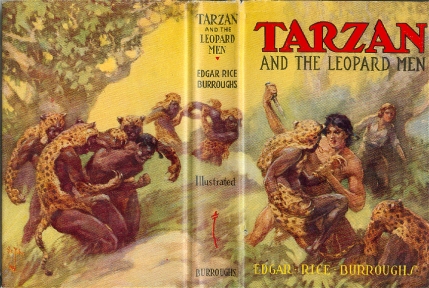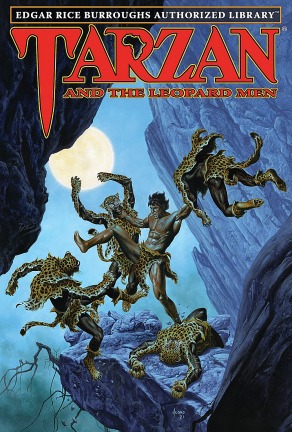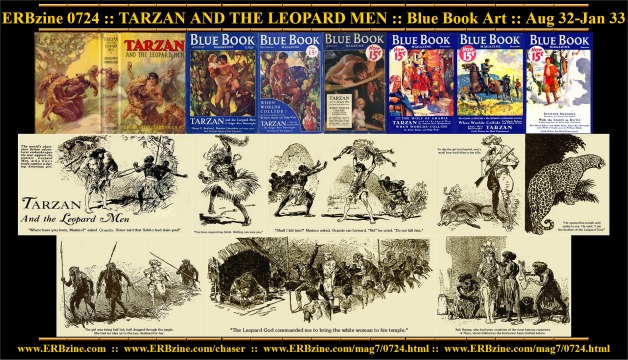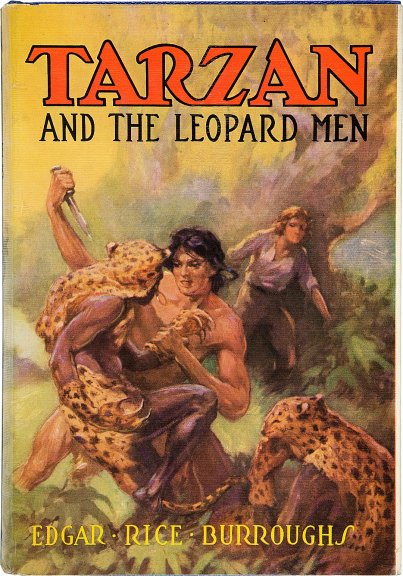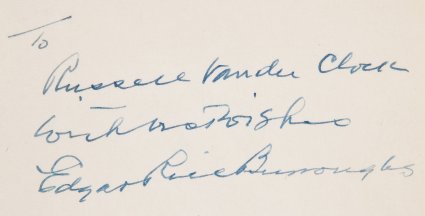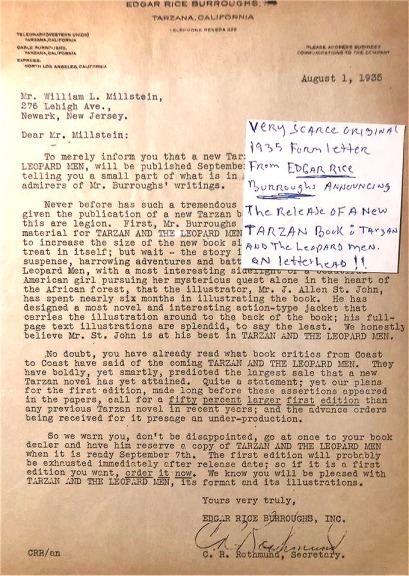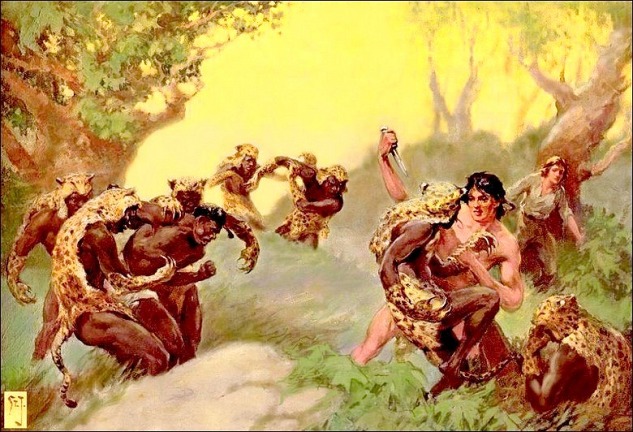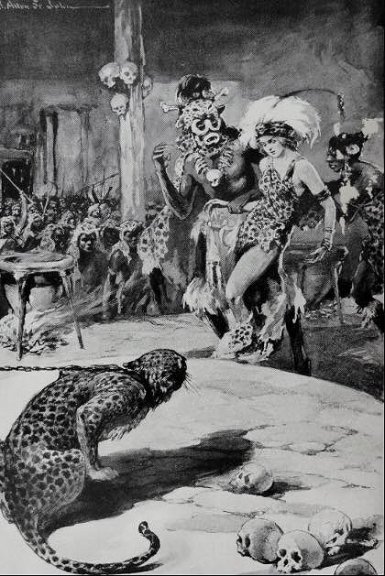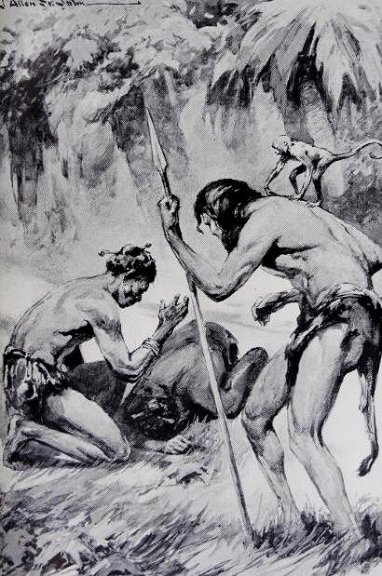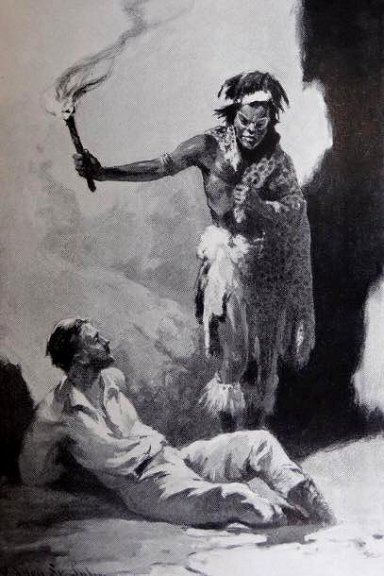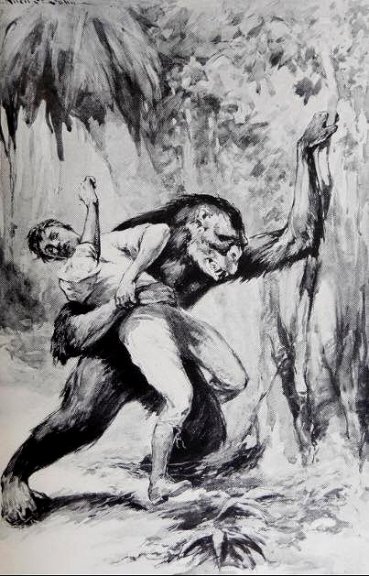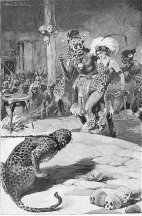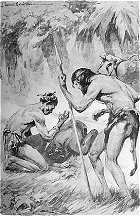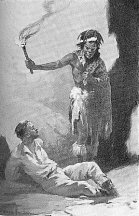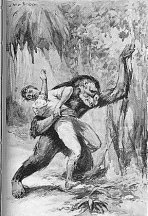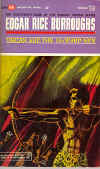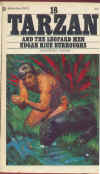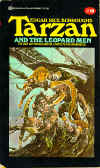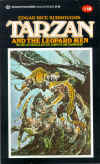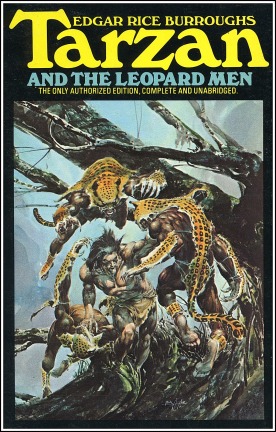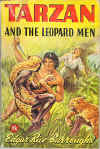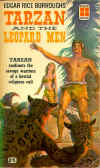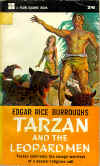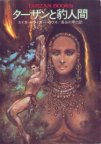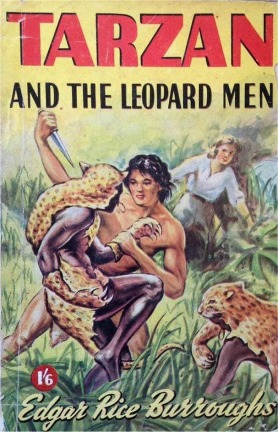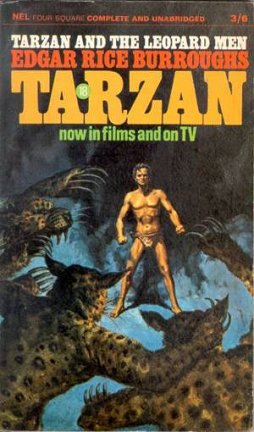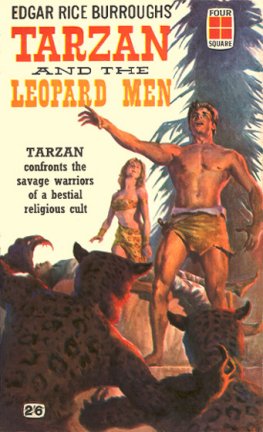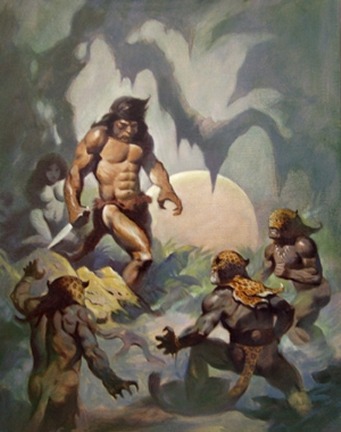TARZAN AND THE LEOPARD MEN
Review contributed by Doc
Hermes ERB Reviews
First published in BLUE BOOK from August 1932 to January
1933. This one was a real chore to slog through. If you are a pulp or adventure
fan who had never read a Tarzan book before and happened upon TARZAN AND
THE LEOPARD MEN, you might think, "Hey, that's not bad. Wonder if there's
any more in this series?" But if you had enjoyed the earlier books (some
of which are just excellent in the genre, like TARZAN THE TERRIBLE or TARZAN
AND THE JEWELS OF OPAR), by the time you got to this eighteenth episode,
serious deja vu will have swamped you.
Actually, it has a fine premise to base an adventure on.
Instead of finding another pair of warring cities originally founded in
Africa somehow by Olmecs or Picts, Tarzan tackles the cult of Leopard Men.
So much could be done with this. A dreaded secret society of African tribesmen
(living unsuspected in their various villages) who don leopard robes and
steel claws to carry out missions of murder and cannibalism... how could
you ask for better villains? And the actual plot of the book uses this
idea (in a lukewarm way), as the Apeman joins forces with Orando of the
Utengi, the only chief brave enugh to stand up to the cult.
There could be savage battles with the killers,
our heroes trying to find out which tribesmen are loyal and which belong
the cult, having a young native forced into the society and struggling
between his loyalty to his family or to the cult. And at the end, one hundred
Waziri led by Muviro would come charging down for a big slaughter. It could
have been a great yarn.
But no. By this time, Burroughs was grudgingly cranking
out stories about a character he had long since grown tired of. I personally
felt the series peaked around TARZAN AND THE ANT MEN and then twisted its
ankle and tumbled downhill fast (with an occasional flash of the old spark
here and there.) There are large stretches in this book that I half suspect
were pasted out of earlier epics with new names pencilled in.
At the very beginning, Tarzan is in a tree in a storm,
when a tornado (a TORNADO? In the jungle?) sends him crashing down and
leaves him pinned helplessly under a huge branch. Once again, a concussion
has left him able to speak and reason but has wiped away all memory of
his identity. (Just once, I would like to see a head injury leave Tarzan
talking like a duck or seeing everything upside down for a while, instead
of just this selective amnesia.) Or course, later on, a second sharp smack
to the cranium instantly restores all his memories and he's not any worse
for all the head trauma.
I really don't see the narrative purpose of this particular
session of "Who am I?" Tarzan is taken to be a spirit by Orando and is
renamed Muzimo (and little N'Kima the kvetching monkey is now believed
to be the ghost of the slain warrior Nyamwegi). What's the point of all
this? If I didn't know better, I'd suspect Burroughs was trying to fill
up page after page with Tarzan trying half-heartedly to remember his real
name and Orando speculating on muzimo theology.
And frankly, it would be a lot more exciting if Tarzan
found evidence that the Leopard Men were active again, that they were terrorizing
tribes who were under his protection and were defying his law. Imagine
the Apeman standing up after searching for life in the victims of a massacred
village, growling "Leopard Men....again!" and then hurtling up into the
trees to begin his war. It would have made him seem genuinely heroic, Lord
of the Jungle in more than nickname.
The other half of the story involves three white Americans
who keep running into each other, being captured and rescued, escaping
one pickle after another and in general carrying on like the exact same
characters in half a dozen earlier books. There's the Playboy centerfold
candidate called Kali Bwana, who is looking for her lost brother; there
are two ivory hunters, Old Timer and the Kid. (Wait, wait... don't tell
me who the kid really is, I think I can guess.) Almost inevitably, Old
Timer and Kali Bwana get off on the wrong foot, hold unreasonable grudges
against each other throughout all their adventures together and stubbornly
resist the instant True Love that boings up between them like a stepped-on
rake. Huh, did I doze off? Is it 11:45 already... what page was I on?
Anyway, there are a few moments where we get a glimpse
of the old magic that made Edgar Rice Burroughs in his prime such a major
pulp writer. The scenes in the Leopard Man temple hidden on an island guarded
by crocodiles are lurid and ominous enough (a hand falls out of the merrily
bubbling stew pot). And there is a moment when Kali Bwana lies trembling
as a leopard crouches and is ready to spring at her... and hurtling up
silently behind the cat silently a huge bronzed giant. This was one of
the few scenes where I got a clear visual snapshot.
Some of the racial snarks are a bit more blatant than
usual ("He saw that religious and alcoholic drunknness were rapidly robbing
them of what few brains and little self-control Nature had vouchsafed them")
and we don't see enough of the noble Utengi tribe to counter-balance that
impression. Also, it's disquieting to see Burroughs ragging on Pygmies
the way he does. I read a couple of books years ago by a man named Jean-Pierre
Hallet (CONGO KITABU and PYGMY KITABU*) who lived among these people for
years (and in fact grew up with them until he was six). He never mentioned
that they were cannibals, filed their yellow teeth to points or beat their
captives, and other reference or travel books also gave a different impression
than Burroughs did. Maybe Kali Bwana just fell in with a particularly riff-raff
Pygmy (more correctly called Khoi-San?) tribe, I guess.
Finally, a couple of Mangani make a belated appearance
and it's worth noting that they are definitely a unique species. "It was
evident that they were not gorillas, and that they were more man-like than
any apes he had seen." I'd like to see the next Tarzan movie or TV show
dwell on this and show the Mangani as sort of Bigfoot or hominid creatures,
contrasting them with a actual live gorillas to make the point.
__________
*Here: http://www.pygmyfund.org/eulogy.html
is a eulogy page for Hallet. As you can tell, he was an interesting guy
who led a more exciting life than most of us. Hallet had good observational
skills and a clear writing style, but he also had a strong political bias
and some of his speculation about African anthropology was, well, imaginative.
(As I recall, he thought all the world's religions had their source in
Pygmy beliefs.) Great material for thrillers, though -- it's too bad Robert
E Howard couldn't somehow have been sent back copies of Hallet's books...
think of the plots he might have spun from some of those incidents!

